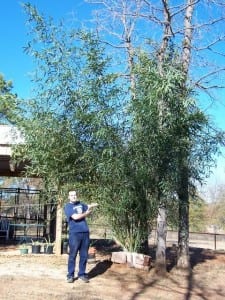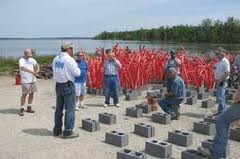DUPONT – The DuPont City Council last night authorized the city’s mayor to sign a settlement agreement allowing development of a plan to restore the Sequalitchew Creek watershed, including Edmond Marsh. The Settlement Agreement also allows CalPortland Co. (CalPortland) to apply for gravel mining and reclamation permits in areas adjacent to its existing mine. The City Council, by a vote of 5 to 1, has now joined in the accord – negotiated over a three-year period ending in 2011.
See the dozens of unique artificial fish habitat models, fish attractors and fish cover used at fishiding.com, the leader in science based, proven, fish protection.
The City Council’s action was the final step needed to ratify the 2011 DuPont Settlement Agreement. The other signers are: the Nisqually Delta Association; the Washington Environmental Council; People for Puget Sound; the Tahoma, Black Hills and Seattle chapters of the National Audubon Society; the Anderson Island Quality of Life Committee (together known as the Environmental Caucus); CalPortland; the Washington State Department of Ecology (Ecology); and now the City of DuPont.
The agreement describes a process that the parties agree to follow to restore flows to Sequalitchew Creek using funds provided by CalPortland. The idea is to permanently protect Sequalitchew Creek and the ravine it flows through before emptying into Puget Sound. The agreement also establishes a number of conditions under which CalPortland may submit applications to access additional areas designated for gravel extraction under the City’s Comprehensive Plan and the State Growth Management Act. The agreement does not approve or authorize any mining. It only establishes the conditions under which the Environmental Caucus agrees not to oppose CalPortland’s applications. Both the restoration plan and mining proposal will undergo the normal review processes, including opportunities for public input. Any mining proposal will need to complete the entire regulatory process and meet all regulatory requirements in addition to being dependent on the successful development, environmental review, permitting and funding of the watershed restoration plan.
DuPont Mayor Michael Grayum said: “This comprehensive agreement is about our environment and our economy, both in our city and throughout the region. It’s not often that environmental leaders, industry, and a local government and regulatory agency come together to agree upon a process with enough checks and balances to protect the broader community interests and help restore the environmental condition of our watershed. We appreciate the many subject matter experts, neighbors, organizations and regulatory entities involved in this lengthy negotiation. Looking forward, we also appreciate the many others who will develop and implement the restoration plan for Sequalitchew Creek.”
Tom Skjervold, president of the Nisqually Delta Association, representing the Environmental Caucus, said: “We want to thank the City Council, the Mayor and City staff for their careful and detailed consideration of this agreement. After three years of negotiations to reach the 2011 Settlement Agreement, we’re now ready to begin the process of developing the restoration plan for the Sequalitchew Creek watershed. We look forward to working with the City, the DuPont community, Joint Base Lewis-McChord and local, state and federal regulatory agencies to ensure that mining and reclamation are done responsibly and that the watershed is restored.”
Pete Stoltz, CalPortland’s permit manager, said: “We also want to thank the Mayor, the City Council and staff for their careful consideration of the agreement. We want to carry forward the positive, cooperative relationship we have with the Environmental Caucus, Ecology and the City to other stakeholders and restore flows and fish habitat in Sequalitchew Creek. This is a great opportunity for the community to restore an important natural and historic feature and for us to continue providing needed sand and gravel resources to the region. We look forward to working with the community on the restoration plan and the environmental studies because these sand and gravel resources are needed for our region’s economic recovery and to get many unemployed workers back on the job.”
Sally Toteff, Ecology’s Southwest Region director, said: “This continuation of the 1994 Settlement Agreement includes preservation of 45 acres of Puget Sound shore lands and adjacent open space as well as improving flows in Sequalitchew Creek – both of which will help restore South Puget Sound. Our negotiations were able to bring private entities, government agencies and local and regional environmental groups together to create an extraordinary opportunity for long-awaited restoration to occur.”
The parties will work with South Puget Sound Salmon Enhancement Group (SPSSE), Joint Base Lewis-McChord and the Nisqually Tribe – with input from citizen and community groups and government agencies – to develop and implement the restoration plan. After needed permits are received, SPSSE will manage implementation of the plan, with additional input from the community and other key stakeholders. CalPortland will provide funding for developing, reviewing, permitting and implementing the plan.
“This was a long and at times very tough negotiation, but early on we saw the potential for a settlement when we were able to quickly agree on a clear set of goals that called for restoring and enhancing the Sequalitchew Creek watershed, including restoration of stream flows along the entire creek,” Skjervold said. “The creek has had problems for more than half a century, and for at least 25 years now there have been a number of efforts to restore parts of the watershed. However, this is the first time we’ve had a chance to address the watershed as an ecologically integrated whole: from Sequalitchew Lake, through the group of marshes, down the length of the creek and into Puget Sound. We kept this clearly in mind when linking any mining proposal with a requirement for restoring and enhancing the watershed.”
Changes in the watershed and creek channel in the 1800s and early 1900s harmed fish habitat and water flow over time. Recent studies show that even modest increases in the water flowing through the creek would dramatically improve access to, and quality of, its fish habitat.
The Settlement Agreement also includes a process for developing a strong monitoring program. This program will be designed to ensure that the restoration plan works during mining, reclamation and when the area is redeveloped according to its underlying zoning.
“The ideas we discussed during negotiations, and those developed as the plan is being completed, will be designed to help restore and enhance the marsh and creek,” Skjervold said. “The requirement for a monitoring program will ensure that members of the Environmental Caucus and the community will know how the plan is actually working.”
The mediated negotiations that resulted in the settlement agreement were held among parties that might otherwise have engaged in lengthy and costly litigation.
“We think we achieved a fair balance that protects and enhances the habitat in Edmond Marsh and Sequalitchew Creek, but still allows an application to be made for gravel mining in areas designated for this purpose,” Stoltz said. “There will be additional environmental and permitting review of any gravel mining proposal. Regardless of the outcome, no mining can occur in the South Parcel mining area unless an approved watershed restoration plan is developed, permitted and implementation begins.”
More information about the agreement is available for review on:
The Department of Ecology’s website (http://www.ecy.wa.gov/puget_sound/index.html)
DuPont’s website (http://www.ci.dupont.wa.us/)
CalPortland’s DuPont website (http://www.calportlandresources.com/dupont/default.aspx)
###
Media Contacts:
- Sally Toteff, Southwest Region director, Department of Ecology (360) 407-6307
- Pete Stoltz, permitting manager, CalPortland (206) 764-3000
- Tom Skjervold, president, Nisqually Delta Association (360) 485-9470
- Michael Grayum, DuPont Mayor (253) 912-5218
###
Fact Sheet: Specifics of the DuPont Settlement Agreement
For more than two decades, various organizations have contemplated restoration of Sequalitchew Creek. However, until the 2011 DuPont Settlement Agreement was negotiated and approved, funding and stakeholder interest were not sufficient to complete the restoration process. The settlement agreement provides stakeholders with an invitation to participate in a process and a reliable source of funding to coordinate, plan, permit and implement restoration. It also obligates CalPortland to pay up to $200,000 for development of a Sequalitchew Creek Restoration Plan, as well as additional funding for the environmental and permitting reviews and the implementation of the plan.
Specifically, the settlement agreement provides:
- Funding for developing a plan to help restore flows from Sequalitchew Lake, through Edmond Marsh and into Sequalitchew Creek, regardless of whether any mine permits are issued. Multiple stakeholders, including DuPont citizen organizations, are invited to take part in this planning.
- Funding for permitting and implementing restoration of Sequalitchew Creek if certain milestones are achieved. Among these are completion of a Supplemental Environmental Impact Statement (SEIS) and agreement on a monitoring plan to be developed by CalPortland and the Environmental Caucus.
- Permanent protection of 45 acres of open space, including nearly a mile of Puget Sound shorelands and adjacent upland property.
- An easement for approximately one mile of pedestrian trail.
The agreement prescribes five elements to the Restoration Plan. These are:
- Restoration of gradients so water discharges from Hamer and Bell marshes flow into Edmond Marsh rather than a diversion canal.
- Improvements to create significant flows from Sequalitchew Lake into the Edmond Marsh complex to support a functional creek ecosystem, and provide for the passage of migratory fish in the Sequalitchew Creek system.
- Rehabilitation of Edmond Marsh by removal of fill and other impediments necessary to achieve and maintain adequate flows through the marsh.
- Rehabilitation of Sequalitchew Creek below Edmond Marsh to reduce seepage, improve fish habitat and help restore year-round flows.
- Active management of beaver activities, using the least intrusive means possible, to maintain the hydraulic gradients that provide flows through Hamer, Bell and Edmond marshes.
At the same time restoration planning proceeds for the creek, the agreement enables CalPortland to develop a gravel mining proposal, which must undergo a new supplemental environmental impact statement review process. This process includes new opportunities for public review and comment. It’s important to note that the agreement does not approve or authorize any mining project. CalPortland must pursue the normal process with regulatory agencies as required by law.
Even if all permits to allow the South Parcel mine plan to proceed are approved, CalPortland will need to complete additional steps and satisfy several criteria before mining can begin, including groundwater testing and monitoring. The agreement also prohibits CalPortland from using any permits that allow mining in its South Parcel unless it satisfies the agreed funding obligation and all permits and approvals are in place to implement the Restoration Plan. However, if a mining permit is appealed, CalPortland will not be required to fund restoration permitting or implementation until either the appeal is resolved or CalPortland begins mining in the South Parcel.
The negotiated terms of the 2011 Settlement Agreement uphold a 1994 agreement to permanently protect Sequalitchew Creek and the ravine it flows through before emptying into Puget Sound.
For more information:
The Department of Ecology’s website (http://www.ecy.wa.gov/puget_sound/index.html)
DuPont’s website (http://www.ci.dupont.wa.us/)
CalPortland’s DuPont website (http://www.calportlandresources.com/dupont/default.aspx)







 The Schoolyard
The Schoolyard 
